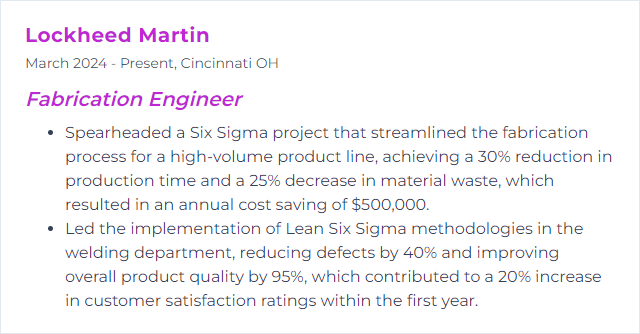Top 12 Fabrication Engineer Skills to Put on Your Resume
In the competitive world of fabrication engineering, the right stack of skills turns heads. Bread-and-butter CAD. Gritty shop-floor know-how. A nose for process flow. Blend them well and your resume stops feeling ordinary.
Fabrication Engineer Skills
- AutoCAD
- SolidWorks
- CNC Programming
- MIG/TIG Welding
- 3D Printing
- Lean Manufacturing
- MATLAB
- Finite Element Analysis
- PLC Programming
- ISO Standards
- GD&T (Geometric Dimensioning and Tolerancing)
- Six Sigma
1. AutoCAD
AutoCAD is a CAD workhorse for precise 2D/3D drawings and models. Fabrication engineers lean on it for clean geometry, tight tolerances, and manufacturing-ready documentation.
Why It's Important
It sharpens accuracy, trims rework, and speeds handoff to the shop. Less guesswork. More repeatable builds.
How to Improve AutoCAD Skills
Shortcuts and aliases: Build muscle memory. Create custom aliases for your most-used commands.
3D and parametrics: Model in 3D when it clarifies fit, weld access, or bend reliefs. Add constraints so changes ripple correctly.
Templates and standards: Lock in layers, linetypes, title blocks, and dimension styles that match shop standards.
Automation: Use dynamic blocks, fields, and scripts (AutoLISP) to kill repetitive clicks.
Clean data: Purge, audit, and maintain tidy drawings to prevent downstream CAM hiccups.
Practice with real parts: Model fixtures, sheet layouts, and weldments you actually build.
How to Display AutoCAD Skills on Your Resume
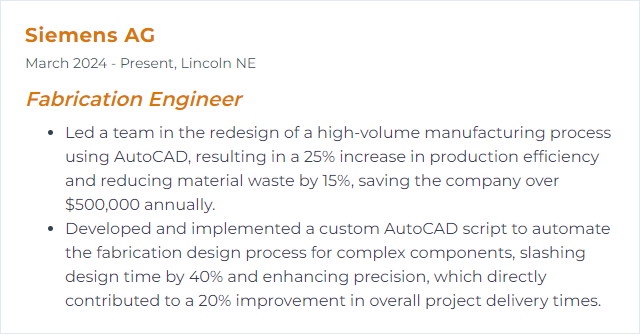
2. SolidWorks
SolidWorks enables robust 3D modeling, assemblies, drawings, and built-in tools for sheet metal, weldments, and simulation—perfect for fabrication-centric design.
Why It's Important
It connects design intent to manufacturability. Faster iterations, fewer surprises, better BOM control.
How to Improve SolidWorks Skills
Sheet metal: Master flat patterns, reliefs, K-factor, and bend tables aligned with your press brakes.
Weldments: Use structural members, cut lists, and end treatments for frames and jigs.
Design for Manufacturing: Bake clearance, bend radii, and tool access into models early.
Configurations and design tables: Drive families of parts without duplicating work.
Simulation basics: Run quick checks on stiffness, buckling, and thermal where it matters.
Custom properties: Automate part metadata for drawings and PDM.
How to Display SolidWorks Skills on Your Resume
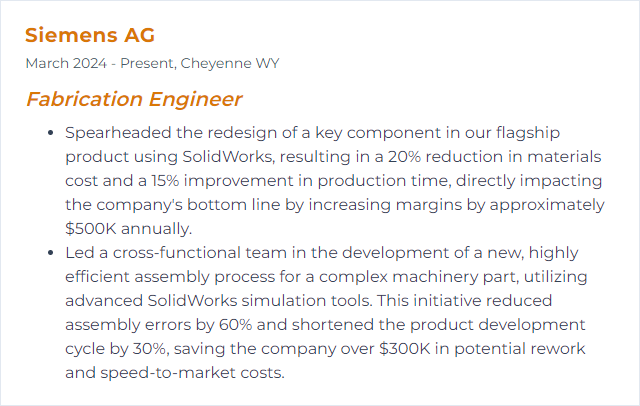
3. CNC Programming
CNC programming converts models and drawings into toolpaths and machine code that cut, drill, turn, and mill raw stock into spec parts.
Why It's Important
It drives precision, repeatability, and throughput. Good code saves tools, time, and scrap.
How to Improve CNC Programming Skills
CAM proficiency: Get fluent with your CAM suite. Post-process reliably. Validate with backplot and simulation.
Material-savvy: Tune speeds/feeds by alloy and hardness. Watch chip form, heat, and deflection.
Tooling strategy: Choose the right cutters, holders, and stepdowns. Embrace high-efficiency machining where suitable.
Workholding: Rigid, repeatable setups slay chatter and reduce cycle time.
Probing and macros: In-process checks and parametric routines cut setup time and errors.
Document rigor: Setup sheets, tool lists, offsets, and inspection points—clear and current.
Continuous learning: Review toolmaker guides, machinist forums, and shop floor feedback loops.
How to Display CNC Programming Skills on Your Resume

4. MIG/TIG Welding
MIG (GMAW) feeds a consumable wire and shielding gas for fast, versatile welds. TIG (GTAW) uses a non-consumable tungsten and separate filler for surgical control and exceptional finish.
Why It's Important
Welding quality underpins structural integrity, aesthetics, and throughput. The right process, parameters, and prep make or break a build.
How to Improve MIG/TIG Welding Skills
Fit-up and cleanliness: Perfect joints and clean surfaces are half the weld.
Parameter discipline: Dial voltage, current, travel speed, and gas flow with intention. Keep a parameter log by material and thickness.
Torch control: Steady hands, tight arc length, proper angle. Practice on coupons daily.
Filler and gas choices: Match alloys and shielding gases to the job. Verify certs when required.
WPS/PQR: Use qualified procedures. Validate and maintain procedure records.
Safety: PPE, fume extraction, fire watch, and cylinder handling—non-negotiable.
How to Display MIG/TIG Welding Skills on Your Resume
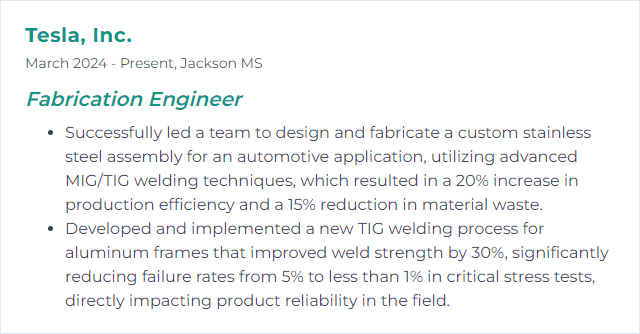
5. 3D Printing
3D printing (additive manufacturing) builds parts layer by layer. It shines for rapid prototypes, intricate geometries, jigs, fixtures, and low-volume custom hardware.
Why It's Important
It shortens iteration, slashes tooling lead time, and opens shapes subtractive methods struggle with.
How to Improve 3D Printing Skills
Material selection: Match polymers, composites, or metals to heat, strength, and chemical needs.
Design for additive: Orient parts smartly, minimize supports, and add fillets, lattices, or ribs where they matter.
Calibration: Verify steps/mm, nozzle offsets, bed leveling, laser focus—regularly.
Slicer mastery: Tune layer height, infill patterns, shells, and support strategies for speed vs. finish.
Post-processing: Deburr, vapor smooth, heat treat, infiltrate, or cure to hit final specs.
Traceability: Log batch, humidity, and machine state for repeatability.
How to Display 3D Printing Skills on Your Resume
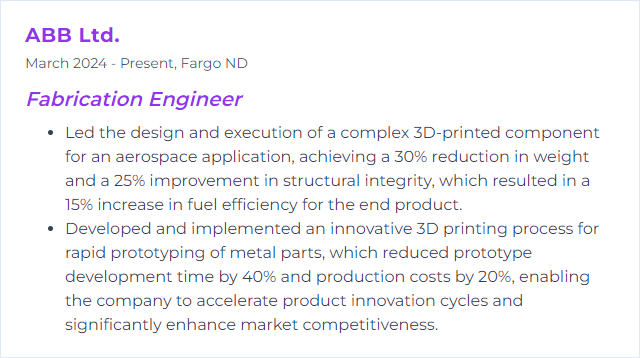
6. Lean Manufacturing
Lean trims waste (time, motion, inventory, defects) while boosting flow, quality, and responsiveness across the shop.
Why It's Important
Better flow means faster lead times, lower cost, fewer headaches. Customers notice.
How to Improve Lean Manufacturing Skills
Value stream mapping: Visualize material and information flow. Target bottlenecks with data, not hunches.
5S: Sort, set in order, shine, standardize, sustain. Make it stick with audits.
Kaizen cadence: Frequent, small improvements beat occasional big ones.
JIT and pull systems: Kanban where sensible. Right-size batches. Reduce WIP.
TPM: Preventive and predictive maintenance to keep machines fight-ready.
Standard work: Clear, visual SOPs that survive shift changes.
Data visibility: Andon, dashboards, daily Gemba walks—make problems obvious.
People first: Train, cross-train, and involve operators in solving the pains they live with.
How to Display Lean Manufacturing Skills on Your Resume
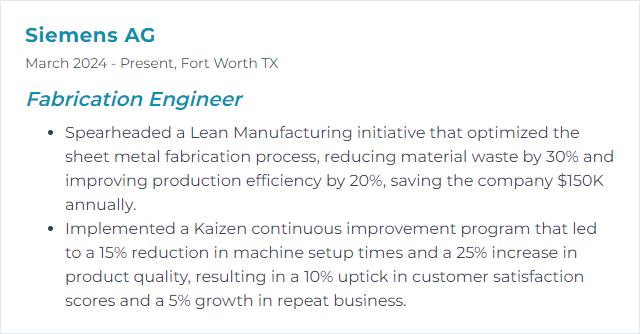
7. MATLAB
MATLAB is a numerical computing environment for modeling, analysis, and automation—handy for process tuning, materials data crunching, and control concepts.
Why It's Important
It turns raw data into actionable parameters. Faster experiments, clearer decisions.
How to Improve MATLAB Skills
Scripting discipline: Write clean functions, avoid copy-paste, and version your code.
Visualization: Use meaningful plots and dashboards to track yield, Cp/Cpk, and process drift.
Toolboxes that matter: Learn Optimization, Statistics and Machine Learning, Curve Fitting, Signal Processing, and Control where applicable.
Simulink basics: Sketch dynamic systems for thermal cycles, motor control, or process loops.
Automation: Batch-run parameter sweeps, parse logs, and generate reports hands-free.
Validation: Compare against hand calcs, test data, and back-of-the-envelope estimates.
How to Display MATLAB Skills on Your Resume
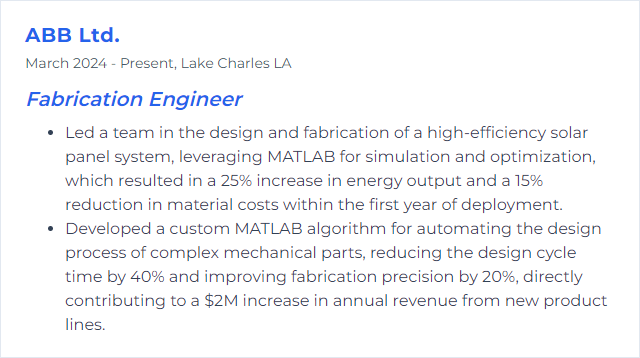
8. Finite Element Analysis
FEA predicts structural, thermal, and modal behavior under load before you cut metal. It helps catch weak spots and overbuilt areas early.
Why It's Important
Better designs with fewer prototypes. Strong where it counts, lean where it doesn’t.
How to Improve Finite Element Analysis Skills
Material truth: Use verified, temperature-dependent properties and weld heat-affected assumptions when needed.
Mesh with intent: Coarse where benign, fine near stress raisers. Run convergence checks.
Boundary conditions: Model supports and contacts like reality, not convenience.
Solver savvy: Pick the right solver for linear, nonlinear, contact, or thermal problems. Mind tolerances.
Correlate: Test, measure, and tune the model until it predicts the real world credibly.
How to Display Finite Element Analysis Skills on Your Resume
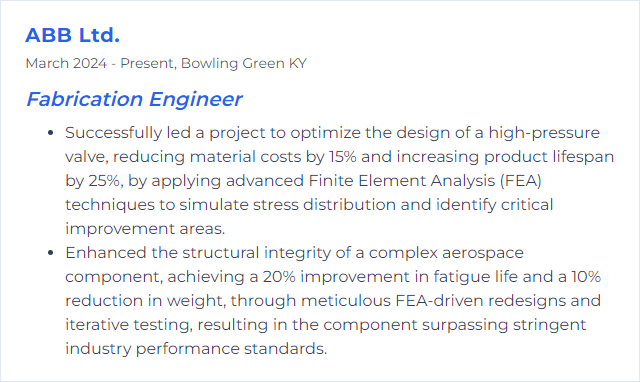
9. PLC Programming
PLC programming defines the logic that runs automated cells, machines, and safety interlocks across the fab floor.
Why It's Important
It ties sensors, actuators, and sequences into a reliable heartbeat. Downtime drops, throughput rises.
How to Improve PLC Programming Skills
Core languages: Get fluent in ladder, function block, and structured text.
Simulation first: Use vendor emulators or open simulators to test logic off-line.
I/O clarity: Standardize tag naming, comments, and fault handling. Future you will thank you.
Motion and PID: Tune loops methodically. Separate safety from standard control logic.
HMI ergonomics: Simple screens, meaningful alarms, lockouts that actually prevent errors.
Change control: Versioning, backups, and documented revisions—always.
Safety standards: Understand risk assessment and functional safety concepts (e.g., performance levels, SIL) for your region.
How to Display PLC Programming Skills on Your Resume
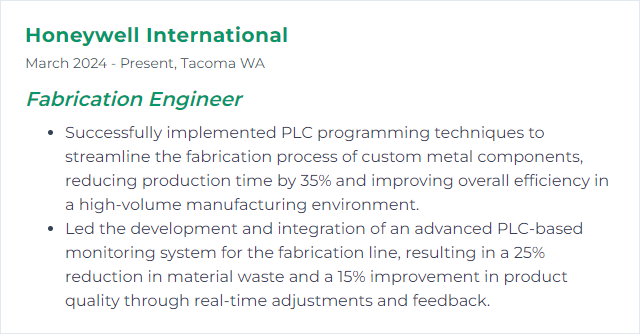
10. ISO Standards
ISO standards codify quality, safety, and environmental expectations so products and processes stay consistent and compliant.
Why It's Important
They reduce variation, improve traceability, and streamline audits—while customers gain confidence.
How to Improve ISO Standards Skills
Know the core: ISO 9001:2015 for quality management. Consider ISO 14001 (environment) and ISO 45001 (OH&S) based on your ops.
Process mapping: Define inputs, outputs, owners, and KPIs. Close the loop with risk-based thinking.
Internal audits: Schedule, sample, and report. Fix root causes, not symptoms.
Document control: Current procedures, controlled records, and training verification.
Supplier quality: Qualify, monitor, and collaborate. Clear specs, fair feedback.
PDCA culture: Plan, do, check, act—relentlessly.
How to Display ISO Standards Skills on Your Resume
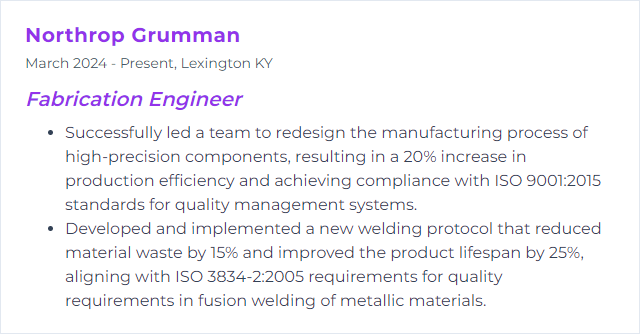
11. GD&T (Geometric Dimensioning and Tolerancing)
GD&T communicates design intent with symbols and datums to control form, orientation, and location—ensuring parts assemble and function under real variation.
Why It's Important
It tightens what matters and relaxes what doesn’t. Fewer rejects. Smoother assemblies. Lower cost.
How to Improve GD&T (Geometric Dimensioning and Tolerancing) Skills
Standards literacy: Study ASME Y14.5 (or ISO GPS equivalents) and apply the latest revisions.
Datum strategy: Choose primary, secondary, tertiary datums that reflect manufacturing and inspection reality.
Feature control frames: Use the right controls—position, profile, flatness, perpendicularity—with sensible modifiers.
Inspectability: If it can’t be measured, it won’t be controlled. Plan CMM/fixtures early.
CAD integration: Use model-based definition and embedded PMI where your workflow supports it.
Practice: Redline drawings, run tolerance stacks, and review NCRs to learn where ambiguity hides.
How to Display GD&T (Geometric Dimensioning and Tolerancing) Skills on Your Resume
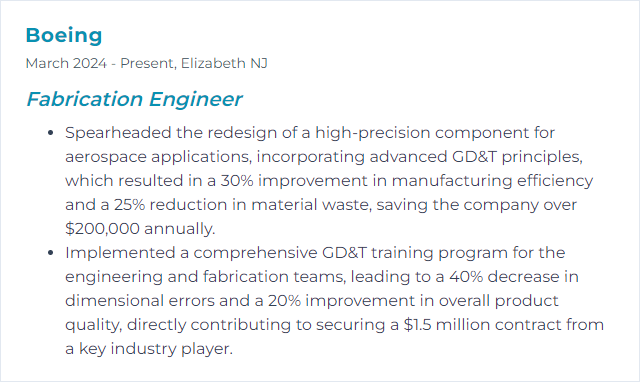
12. Six Sigma
Six Sigma uses data-driven methods to reduce variation and defects. DMAIC is the backbone: define, measure, analyze, improve, control.
Why It's Important
Sharper processes, tighter yields, lower cost. Quality you can prove.
How to Improve Six Sigma Skills
Measurement system analysis: Gauge R&R before chasing phantom problems.
Stats in practice: Control charts, capability studies, regression, DOE—apply where signal beats noise.
Root cause discipline: 5 Whys, fishbone, and hypothesis testing—not guesswork.
Standardize gains: Error-proofing, visual controls, and SOP updates to lock improvements.
Cross-functional teams: Quality, production, design, and supply chain aligned on the same metric.
Tools that fit: Use software for analysis (e.g., MSA, SPC) and keep templates for repeat projects.
How to Display Six Sigma Skills on Your Resume
